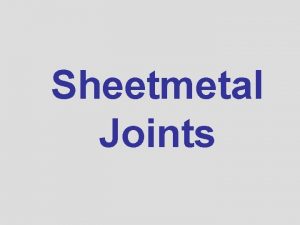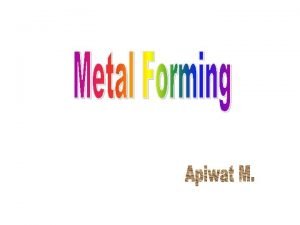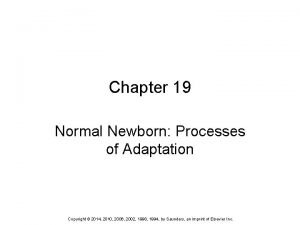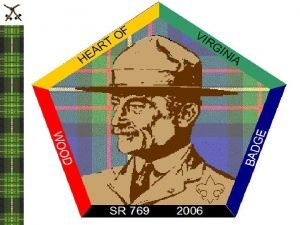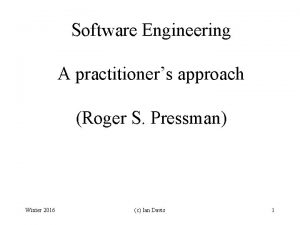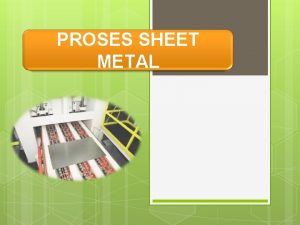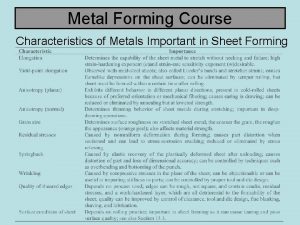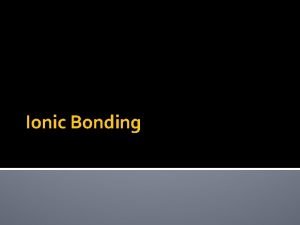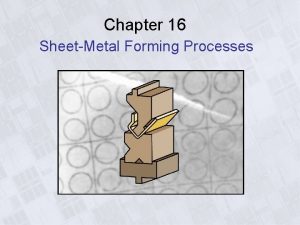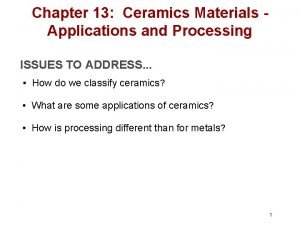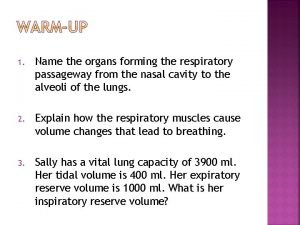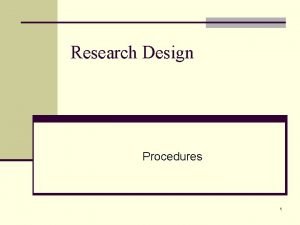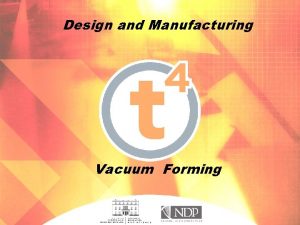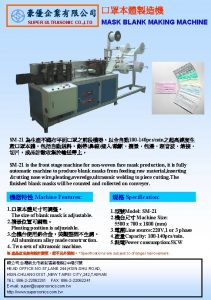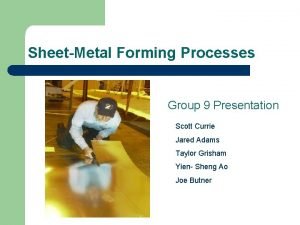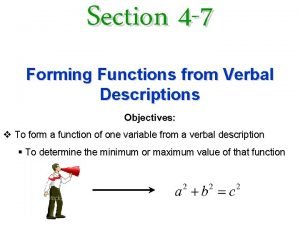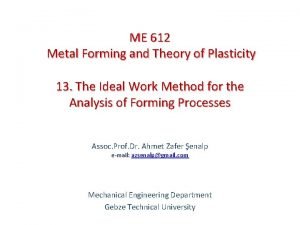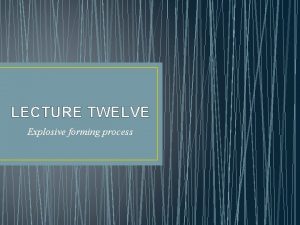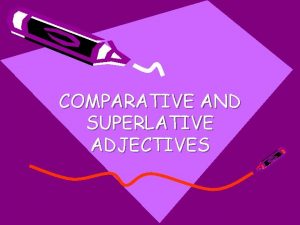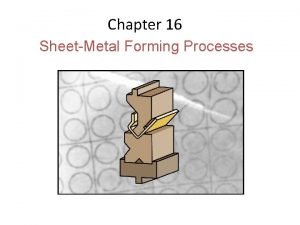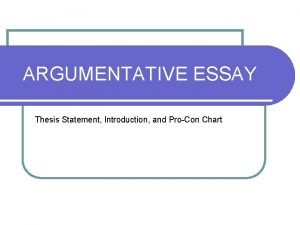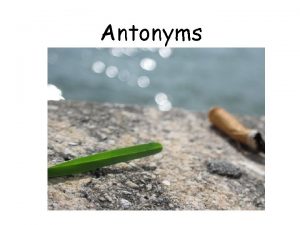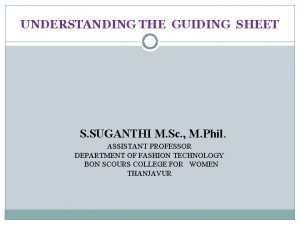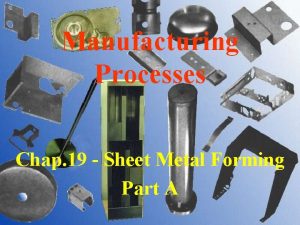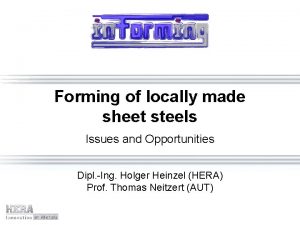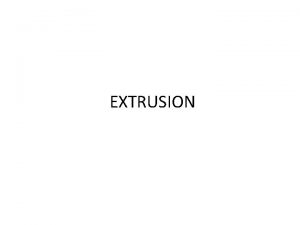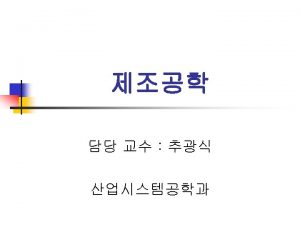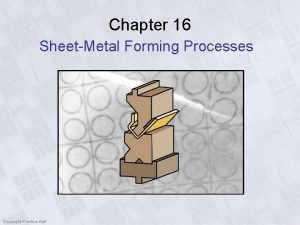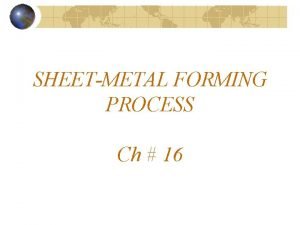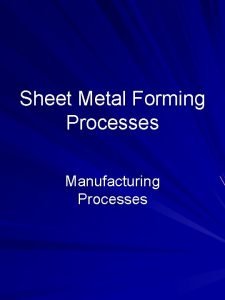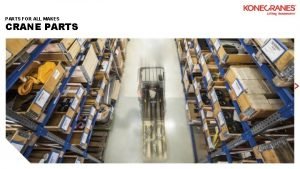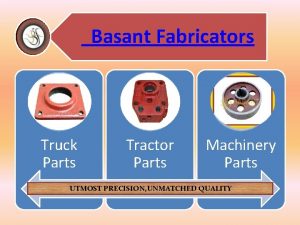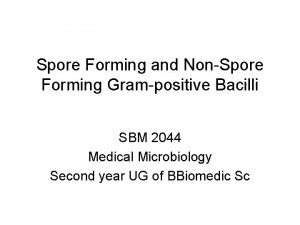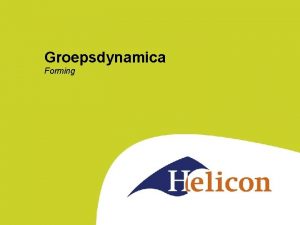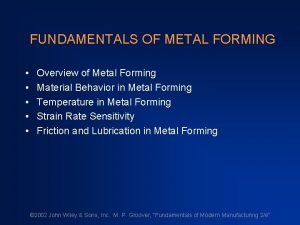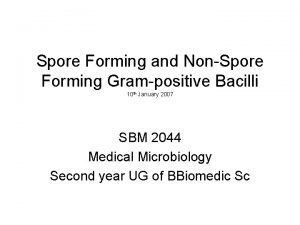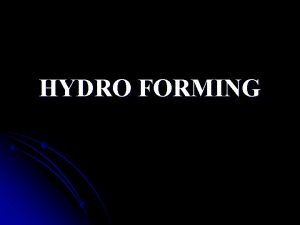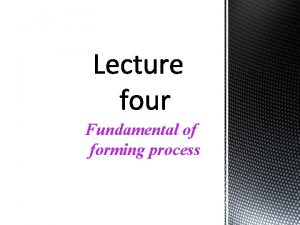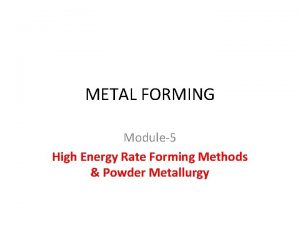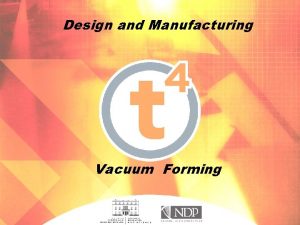Chapter 16 SheetMetal Forming Processes SheetMetal Parts a





















































- Slides: 53

Chapter 16 Sheet-Metal Forming Processes

Sheet-Metal Parts (a) (b) Figure 16. 1 Examples of sheet-metal parts. (a) Die-formed and cut stamped parts. (b) Parts produced by spinning. Source: (a) Courtesy of Aphase II, Inc. (b) Courtesy of Hialeah Metal Spinning, Inc.

Shearing • • • Shearing: mechanical cutting of materials without the formation of chips or the use of turning or melting. Shearing starts with the formation of cracks on both top & bottom edges of wp (A, B, C, D). Shearing parameters: 1. Shape of & materials for punch and die. 2. Punching speed. 3. Lubrication 4. Clearance, c, between punch & die. As c inc, the sheared edge becomes rougher, and the zone of deformation becomes larger (F 16. 2)

Shearing with a Punch and Die Figure 16. 2 (a) Schematic illustration of shearing with a punch and die, indicating some of the process variables. Characteristic features of (b) a punched hole and (c) the slug. (Note: The scales of the two figures are different. )

Shearing • Ratio of burnished to rough areas on sheared edge increases with increasing ductility of sheet metal, and decreases with increasing sheet thickness & clearance. • c = 2 -10% of the sheet thickness. • As the punch speed increases, heat generated by plastic deform is confined to smaller zone; therefore the shear zone is narrower, and the surface is smoother and exhibits less burr formation. • Burr height increases with increasing clearance and ductility of sheet metal. • Edge quality improve with increasing punch speed (10 -12 m/s) Figure 16. 3 (a) Effect of the clearance, c, between punch and die on the deformation zone in shearing. As the clearance increases, the material tends to be pulled into the die rather than be sheared. In practice, clearances usually range between 2 and 10% of the thickness of the sheet. (b) Microhardness (HV) contours for a 6. 4 -mm (0. 25 -in. ) thick AISI 1020 hotrolled steel in the sheared region. Source: After H. P Weaver and K. J. Weinmann.

Shearaing Force and Shearing Operations • Max Punch force, F = 0. 7 TL(UTS) Where: T = sheet thickness, L = total sheared length. • As clearance increases, punch force decreases, and wear on dies & punches decreases. Shearing operations • Die cutting: a shearing process that consists of the following operations (F 16. 4): Perforating – parting – notching – lancing. Figure 16. 4 (a) Punching (piercing) and blanking. (b) Examples of various die-cutting operations on sheet metal.

Shearing Operations 1) Piercing - The typical punching operation, in which a cylindrical punch pierces a hole into the sheet. 2) Slotting - A punching operation that forms rectangular holes in the sheet. Sometimes described as piercing despite the different shape. 3) Perforating - Punching a close arrangement of a large number of holes in a single operation. 4) Notching - Punching the edge of a sheet, forming a notch in the shape of a portion of the punch. 5) Nibbling - Punching a series of small overlapping slits or holes along a path to cutout a larger contoured shape. This eliminates the need for a custom punch and die but will require secondary operations to improve the accuracy and finish of the feature. 6) Lancing - Creating a partial cut in the sheet, so that no material is removed. The material is left attached to be bent and form a shape, such as a tab, vent, or louver. 7) Slitting - Cutting straight lines in the sheet. No scrap material is produced. 8) Parting - Separating a part from the remaining sheet, by punching away the material between parts. 1 2 3 4 5 6 7 8

Fine-Blanking • Very smooth and square edges can be produced by fine blanking (Fig. 16. 5 a). • A V-shaped stinger or impingement mechanically locks the sheet tightly in place and prevents the type of distortion of the material shown in Figs. 16. 2 b and 16. 3. • Clearances: 1% sheet thick, Sheet thick: 0. 5 to 13 mm, Dim tolerances: ± 0. 025 – 0. 05 mm Figure 16. 5 (a) Comparison of sheared edges produced by conventional (left) and by fine-blanking (right) techniques. (b) Schematic illustration of one setup for fine blanking. Source: Courtesy of Feintool U. S. Operations.

Slitting (F 16. 6): blades follow either a straight line or circular or curved path. Two types of slitting equipment: 1. Driven type: powered blades. 2. Pull-through type: strip is pulled through idling blades Figure 16. 6 Slitting with rotary knives. This process is similar to opening cans.

Steel Rules and Nibbling Steel Rules: • Soft metals (as Well as paper, leather, and rubber) can be blanked with a steel-rule die. • The die consists of a thin strip of hardened steel bent into the shape to be produced. • The die is pressed against the sheet, which rests on the flat surface, and it shears the sheet along the shape of the steel rule. Nibbling: • a machine called a nibbler moves a small straight punch up and down rapidly into a die. • A sheet is fed through the gap and many overlapping holes are made which forms the desired path. • Very high flexibility and intricate slots and notches can be made. • Economical for small production runs because of no special dies and punches.

Tailor-Welded Blanks Scrap in shearing: as high as %30 on large stampings. Scrap can be reduced by proper arrangement the shapes on the sheet to be cut (nesting) Figure 16. 7 Production of an outer side panel of a car body by laser buttwelding and stamping. Source: After M. Geiger and T. Nakagawa.

Characteristics and Type of Shearing Dies • Clearances: depend on 1. 2. 3. • • • Type of material, its temper Thickness and size of blank Blank’s proximity to edges of original sheet The thicker the sheet is, the larger the Clearances must be. Small holes require more clearance than larger ones. Clearance range: 2 -8% typical, may be as small as 1% or as large as 30%. • Shaving process (F 16. 9): extra material from rough sheared edges is trimmed. • As a general guidelines, a) clearances for soft materials are less than those for harder grades; (b) the thicker the sheet, the larger the clearance must be; and (c) as the ratio of hole diameter to sheet thickness decreases, clearances should be larger.

The Shaving Process Figure 16. 9 Schematic illustrations of the shaving process. (a) Shaving a sheared edge. (b) Shearing and shaving combined in one stroke.

Shear Angles Punch & die shape: beveling suitable for shearing thick blanks, because it reduces force at beginning of stroke, lower noise. Figure 16. 10 Examples of the use of shear angles on punches and dies.

16. 2 Shearing - Dies • Compound dies: several operations on the same strip performed in one stroke at one station (F 16. 11). • Simple shapes are made because the process is slow and the dies become much more expensive. • Progressive dies: sheet metal is fed through as coil strip, and different operation is performed at the same station with each stroke of a series of punches (F 16. 11 c). • Transfer dies: sheet metal undergoes different operations at different stations, which are arranged along straight line or circular path. • Tool & die materials: tool steels for shearing, carbides for high production rates

Compound Die and Progressive Die Figure 16. 11 Schematic illustrations: (a) before and (b) after blanking a common washer in a compound die. Note the separate movements of the die (for blanking) and the punch (for punching the hole in the washer). (c) Schematic illustration of making a washer in a progressive die. (d) Forming of the top piece of an aerosol spray can in a progressive die. Note that the part is attached to the strip until the last operation is completed.

Miscellaneous Methods of Cutting Sheet Metal • Band saw –metal material removal process that produces chips as in other machining • Flame cutting –especially for thick steel plates, as in shipbuilding • Laser-beam cutting –newer process used with computer controlled equipment • Plasma cutting –high energy plasma formed by electric arc between tool and work material • Friction sawing –disk or blade that rubs against sheet or plate at high speeds • Water-jet cutting –for metallic and non-metallic workpieces

sheet metal characteristics • • • Elongation: high uniform elongation is desirable for good formability. At necking, true strain = strain hardening exponent, n; thus high n value indicates large uniform elongation. Necking: localized or diffuse, depending on strain rate sensitivity (m) of material. The higher the value of m, the more diffuse the necking becomes. Yield point elongation: after material yields, the sheet stretches farther in certain regions without any increase in the lower yield point, while other regions have not yet yielded, producing the so called Lueder’s band [strain marks]. Lueder’s band: elongated depressions on surface of sheet. To avoid these marks, eliminate or reduce yield point elongation, by reducing thickness of sheet 0. 5% to 1. 5% by cold rolling. Because of strain aging, however, the yield point elongation reappears after a few days at RT. To prevent aging, material should formed within a certain time limit. Anisotropy: two types: Crystallographic anisotropy: preferred orientation of the grains. Mechanical fibering: alignment of impurities, inclusions, and voids throughout the thickness of the sheet. Grain size: the coarser the grain, the rougher is the surface appearance. An ASTM grain size of 7 or finer is preferred for general sheet metal forming operations.

Characteristics of Metals Used in Sheet-Forming

Sheet Metal Figure 16. 12 (a) Yield-point elongation in a sheet-metal specimen. (b) Luder’s bands in a low-carbon steel sheet. (c) Stretcher strains at the bottom of a steel can for household products. Source: (b) Courtesy of Caterpillar Inc.

Formability Tests for Sheet Metals • Formability: ability of sheet metal to undergo the desired shape change without such failures as necking or tearing. 1. Cupping tests: sheet metal specimen is clamped between two circular flat dies, steel ball or round punch is pushed hydraulically into the sheet metal until a crack begins to appear. • The greater the value is of the punch depth d, the greater is the formability of the sheet. Figure 16. 13 (a) A cupping test (the Erichsen test) to determine the formability of sheet metals. (b) Bulge-test results on steel sheets of various widths. The specimen farthest left is subjected to, basically, simple tension. The specimen farthest right is subjected to equal biaxial stretching. Source: Courtesy of Inland Steel Company.

Formability Tests for Sheet Metals 2. Forming Limit Diagram (FLD) • Sheet is marked with grid pattern of circles (2. 5 -5 mm diam). • Blank is stretched over a punch, and the deformation of circles is observed and measured in regions where necking and tearing has occurred. • To develop unequal stretching, specimens are cut to varying widths (F 16. 13 b). • Square specimen produces equal biaxial stretching • Narrow specimen approaches a state of uniaxial stretching. • After a series of such tests is performed at different widths, FLD showing the boundaries between failure and safe regions is constructed (F 16. 14)

Formability Tests for Sheet Metals • Data obtained from different locations in each of the samples shown in F 16. 13 b are plotted as in F 16. 14 b. • The higher the curve, the better the formability of the material. • A compressive minor strain is associated with a higher major strain than is a tensile minor strain of the same magnitude. Thus, it’s desirable for the minor strain to be –ve. • The thicker the sheet, the higher its formability curve, and the more formable it is.

Forming Limit Diagram Figure 16. 14 (a) Strains in deformed circular grid patterns. (b) Forming-limit diagrams (FLD) for various sheet metals. Although the major strain is always positive (stretching), the minor strain may be either positive or negative. In the lower left of the diagram, R is the normal anisotropy of the sheet, as described in Section 16. 4. Source: After S. S Hecker and A. K. Ghosh.

Deformation and Tearing in Sheet Metal During Forming Figure 16. 15 The deformation of the grid pattern and the tearing of sheet metal during forming. The major and minor axes of the circles are used to determine the coordinates on the forming-limit diagram in Fig. 16. 14 b. Source: After S. P. Keeler.

Bending Sheets, Plates, and Tubes • As shown in F 16. 16, the outer fibers of material are in tension, while inner fibers are in compression. • Because of Poisson’s ratio, width of part (bend length, L) in the outer region is smaller, and in the inner region it is larger, than the original width (F 16. 17 c) Figure 16. 16 Bending terminology. Note that the bend radius is measured to the inner surface of the bent part.

Bending Sheets, Plates, and Tubes • Bending allowance, Lb: length of neutral axis in the bend and is used to determine the blank length for a bent part Lb = a (R + k. T). K = 0. 33 for R<2 T to 0. 5 for R>2 T • Engineering strain, • As R/T decreases, tensile strain at outer fiber increases, and the material cracks. • Minimum bend radius (MBR) [R]: Radius at which a crack appears on the outer surface of the bend, Where: r = tensile reduction of area • To increase the bendability of metals, increase their tensile reduction of area either by heating or by bending in a highpressure environment.

Bendability depends on: A. Tensile reduction of area-Ductility- (r); As (r) increases, Bendability increases. B. The edge condition of the sheet; bendability decreases as edge roughness increases. C. The amount, shape, and hardness of inclusions present in the sheet metal Figure 16. 17 (a) and (b) The effect of elongated inclusions stringers) on cracking as a function of the direction of bending with respect to the original rolling direction of the sheet. (c) Cracks on the outer surface of an aluminum strip bent to an angle of 90 degrees. Note also the narrowing of the top surface in the bend area (due to Poisson effect).

Minimum Bend Radius Figure 16. 18 Relationship between R/T ratio and tensile reduction of area for sheet metals. Note that sheet metal with 50% tensile reduction of area can be bent over itself in a process like the folding of a piece of paper without cracking. Source: After J. Datsko and C. T. Yang.

Bending sheet and plate – spring-back Figure 16. 19 Springback in bending. The part tends to recover elastically after bending, and its bend radius becomes larger. Under certain conditions, it is possible for the final bend angle to be smaller than the original angle (negative springback).

Methods of Reducing or Eliminating Springback Figure 16. 20 Methods of reducing or eliminating springback in bending operations. Source: After V. Cupka, T. Nakagawa, and H. Tyamoto.

Bending sheet and plate – spring-back • Max bending force, • For a V die, the bending force can be approximated by: Bending Force • This equation applies to situations in which the punch radius and sheet thickness are small compared to die opening, W. Figure 16. 21 Common die-bending operations showing the die-opening dimension, W, used in calculating bending forces.

Miscellaneous Bending and Related Operations Bending in 4 -slide machine: This process is useful in making seamed tubing, fasteners and various machinery components Roll bending: plates are bent using a set of rolls. By adjusting distance between three rolls, diff curvatures obtained. boilers, cylindrical pressure vessels, Figure 16. 22 Examples of various bending operations.

Miscellaneous Bending and Related Operations 1. Press brake forming: long dies in a mechanical or hydraulic press. – Suitable for small prod runs – Dies: carbon steel or gray-iron Figure 16. 23 (a) through (e) Schematic illustrations of various bending operations in a press brake. (f) Schematic illustration of a press brake. Source: Courtesy of Verson Allsteel Company.

Miscellaneous Bending and Related Operations Beading: periphery of sheet metal is bent into the cavity of a die The bead imparts stiffness to the part by increasing the moment of inertia of that section. Also, beads improve the appearance of the part and eliminate exposed sharp edges that can be hazardous. Figure 16. 24 (a) Bead forming with a single die. (b) and (c) Bead forming with two dies in a press brake.

Miscellaneous Bending and Related Operations • Flanging: a process of bending the edges of sheet metals, usually to 90 degree. In shrink flanging (F 16. 25 a, flange is subjected to comp hoop stresses. In stretch flanging, flange edges are subjected to tensile stresses. • Dimpling (F 6. 25 b): 1 st a hole is punched, then is expanded into a flange. Flanges may be produced by piercing with a sharp punch Figure 16. 25 Various flanging operations. (a) Flanges on a flat sheet. (b) Dimpling. (c) The piercing of sheet metal to form a flange. In this operation, a hole does not have to be prepunched before the punch descends. Note, however, the rough edges along the circumference of the flange. (d) The flanging of a tube. Note thinning of the edges of the flange.

Miscellaneous Bending and Related Operations Roll Forming: metal strip is bent in stages by passing it through a series of rolls. Sheet thickness: 0. 125 -20 mm. Forming speeds: below 1. 5 m/s. Rolls: carbon steel or gray iron, may be chromium plated. Figure 16. 26 (a) Schematic illustration of the roll-forming process. (b) Examples of roll-formed cross-sections. Source: (b) Courtesy of Sharon Custom Metal Forming, Inc.

Tube bending and forming Figure 16. 27 Methods of bending tubes. Internal mandrels or filling of tubes with particulate materials such as sand are often necessary to prevent collapse of the tubes during bending. Tubes also can be bent by a technique consisting of a stiff, helical tension spring slipped over the tube. The clearance between the OD of the tube and the ID of the spring is small, thus the tube cannot kink and the bend is uniform.

Tube bending and forming- Bulging: placing a tabular, conical, or curvilinear part into a slit-female die and then expanding it, usually with polyurethane plug (F 16. 28). Punch is then retracted, the plug returns to its original shape, and the formed part is removed Figure 16. 28 (a) The bulging of a tubular part with a flexible plug. Water pitchers can be made by this method. (b) Production of fittings for plumbing by expanding tubular blanks under internal pressure. The bottom of the piece is then punched out to produce a “T. ” Source: After J. A. Schey.

Manufacturing of Bellows Figure 16. 29 Steps in manufacturing a bellows.

Stretch-Forming Process • Sheet metal is clamped along its edges and then stretched over a die or form block, which moves upward, downward, or sideways (F 16. 30) • Dies: zinc alloys, steel, plastics, or wood. Figure 16. 30 Schematic illustration of a stretch-forming process. Aluminum skins for aircraft can be made by this method. Source: Courtesy of Cyril Bath Co.

Deep Drawing • A Process in which a punch forces a flat sheet metal blank into a die cavity. • • Drawing variables: 1. Properties of sheet metal. 2. Ratio of blank diameter (Da) to punch diameter (Dp). 3. Clearance © between punch & die. 4. Punch radius Rp. 5. Die corner radius (Rd). 6. Blank holder force. 7. Friction and lubrication. The punch force increases with increasing in strength, diameter, and thickness of sheet metal blank.

Deep-Drawing Figure 16. 32 (a) Schematic illustration of the deep-drawing process on a circular sheetmetal blank. The stripper ring facilitates the removal of the formed cup from the punch. (b) Process variables in deep drawing. Except for the punch force, F, all the parameters indicated on the figure are independent variables.

Can Manufacture Figure 16. 31 The metalforming processes involved in manufacturing a two-piece aluminum beverage can.

Deep drawing • Ironing: the process of thinning the walls of a drawn cylinder by passing it between a punch and die whose separation is less than the original wall thickness. Aluminum beverage cans, undergo two or three ironing operations in one stroke in which the drawn cup is pushed through a set of ironing rings. • Drawing without blank holder: Do – Dp < 5 T. • Embossing: shallow or moderate draws, made with male and Female shallow matching dies. • Dies: tool steels and cast irons • Equipment: double action hydraulic press or mechanical press • Punch speeds: 0. 1 -0. 3 m/s.

Embossing with Two Dies Figure 16. 37 An embossing operation with two dies. Letters, numbers, and designs on sheet-metal parts can be produced by this process.

Aluminum Beverage Cans (a) Figure 16. 38 (a) Aluminum beverage cans. Note the excellent surface finish. (b) Detail of the can lid showing integral rivet and scored edges for the pop-top.

Rubber Forming and Hydroforming Bending and Embossing of Sheet Metal: the outer surface of the sheet is protected from damage or scratches, because it is not in contact with a hard metal surface during forming. Pressures in rubber forming are typically on the order of 10 MPa Figure 16. 39 Examples of the bending and embossing of sheet metal with a metal punch and with a flexible pad serving as the female die. Source: Courtesy of Polyurethane Products Corporation.

Rubber Forming and Hydroforming Hydroform process: Deeper draws are obtained in deep drawing, because pressure around rubber membrane forces the cup against punch. Advantages of Rubber forming: (1) low tooling cost. (2) flexibility and ease of operation. (3) low die wear. (4) no damage to surface of sheet. (5) capability to form complex shapes Figure 16. 40 The hydroform (or fluid-forming) process. Note that in contrast to the ordinary deep-drawing process, the pressure in the dome forces the cup walls against the punch. The cup travels with the punch; in this way, deep drawability is improved.

Rubber Forming and Hydroforming Tube. Hydroforming Figure 16. 41 (a) Schematic illustration of the tube-hydrofroming process. (b) Example of tube-hydroformed parts. Automotive exhaust and structural components, bicycle frames, and hydraulic and pneumatic fittings are produced through tube hydroforming. Source: Courtesy of Schuler Gm. BH. (b)

Spinning - Conventional spinning (CS) • Spinning involves the forming of axisymmetric parts over a mandrel, by use of various tools and rollers. • CS: a circular blank of flat or preformed sheet metal is held against a mandrel and rotated, while a rigid tool deforms and shapes the material over mandrel (F 16. 40 a). • Tool activated manually or by computer controlled mechanism. • Suitable for conical and curvilinear shapes. • Part diameters: up to 6 m. Figure 16. 42 (a) Schematic illustration of the conventional spinning process. (b) Types of parts conventionally spun. All parts are axisymmetric.

Shear-Spinning and Tube-Spinning • An axisymmetric conical or curvilinear shape is produced, while maintaining part’s max diameter and reducing its thickness (F 16. 41 a). • Part diameter: up to 3 m. • Little waste material, relatively short cycle time (few seconds). • Considerable heat is generated, due to large deformation involved, thus water based fluids are required. • Spinnability: max reduction in thickness to which a part can be subjected by spinning without fracture. • Spinnability is related to tensile reduction of area. Figure 16. 43 (a) Schematic illustration of the shear-spinning process for making conical parts. The mandrel can be shaped so that curvilinear parts can be spun. (b) and (c) Schematic illustrations of the tube-spinning process

Explosive Forming • • • Sheet metal blank is clamped over a die, and entire assembly is lowered into a tank filled with water. Explosive charge is placed at a certain height. The peak pressure, p (psi), in water is given by: – K = constant which depends on type of explosive (21600 for TNT). – W = weight of explosive charge (lb), R = standoff (ft) – a = constant, generally taken to be 1. 15 Steel plates 25 mm thick and 3. 6 m diameter Tubes: wall thickness of 25 mm have been pulged Dies: Al alloys, steel, ductile iron, zinc alloys, reinforced concrete, wood, plastics, composite materials. Figure 16. 45 (a) Schematic illustration of the explosive forming process. (b) Illustration of the confined method of the explosive bulging of tubes.
 What is a self-secured joint?
What is a self-secured joint? 4 soil forming processes
4 soil forming processes Difference between bulk deformation and sheet metal forming
Difference between bulk deformation and sheet metal forming Concurrent processes are processes that
Concurrent processes are processes that Chapter 19 normal newborn processes of adaptation
Chapter 19 normal newborn processes of adaptation How to designing and managing service processes
How to designing and managing service processes Forming storming norming performing
Forming storming norming performing Storming norming conforming performing
Storming norming conforming performing Forming process adalah
Forming process adalah Corynebacterium diphtheriae spore forming
Corynebacterium diphtheriae spore forming Advantage of cold working
Advantage of cold working Fine blanking
Fine blanking Forging is carried out at which temperature mcq
Forging is carried out at which temperature mcq Forming and solving equations worksheet
Forming and solving equations worksheet Constructing equations worksheet
Constructing equations worksheet Unit chemical bonding forming ionic compounds ws 2
Unit chemical bonding forming ionic compounds ws 2 Readers increase their knowledge by forming synthesis.
Readers increase their knowledge by forming synthesis. Forming process in sheet metal
Forming process in sheet metal Die blanks ceramics
Die blanks ceramics Organs forming the respiratory passageway
Organs forming the respiratory passageway Forming research design
Forming research design Question in french
Question in french Thermoforming machine history
Thermoforming machine history Forming questions in spanish
Forming questions in spanish Vacuum forming tips
Vacuum forming tips Malignant neoplasm of the blood-forming organs
Malignant neoplasm of the blood-forming organs In forming ionic bonds
In forming ionic bonds Defect
Defect Ultrasonic mask blank machine
Ultrasonic mask blank machine Roisin currie greggs
Roisin currie greggs Forming functions from verbal descriptions
Forming functions from verbal descriptions Ways of forming phraseological units
Ways of forming phraseological units Theory of metal forming
Theory of metal forming Explosive metal forming
Explosive metal forming Composite funtion
Composite funtion Inverted questions french
Inverted questions french Kinds of fish and shellfish
Kinds of fish and shellfish Crime scene reconstruction involves forming a hypothesis
Crime scene reconstruction involves forming a hypothesis Comparative form sweet
Comparative form sweet Explosive forming
Explosive forming Site:slidetodoc.com
Site:slidetodoc.com Considerate negative prefix
Considerate negative prefix Formal questions in spanish
Formal questions in spanish Forming fabric guiding
Forming fabric guiding Metal forming part
Metal forming part Present perfect slide
Present perfect slide Forming limit curve
Forming limit curve Subjunctive formation
Subjunctive formation Pa nylon spiral tube
Pa nylon spiral tube Hot forming checking fixture
Hot forming checking fixture Star forming
Star forming Star forming
Star forming Fundamentals of metal forming
Fundamentals of metal forming Forming nouns
Forming nouns
